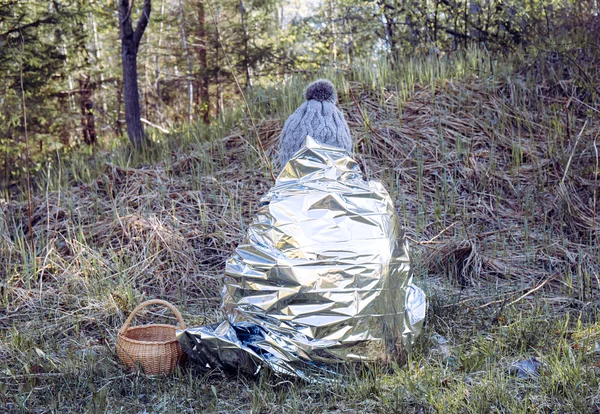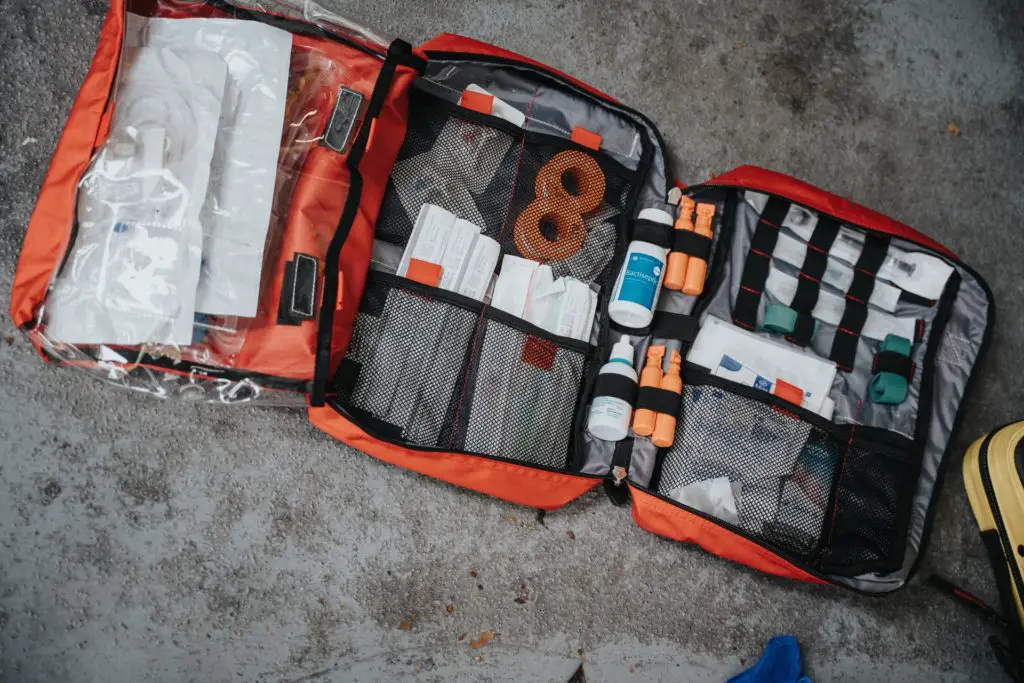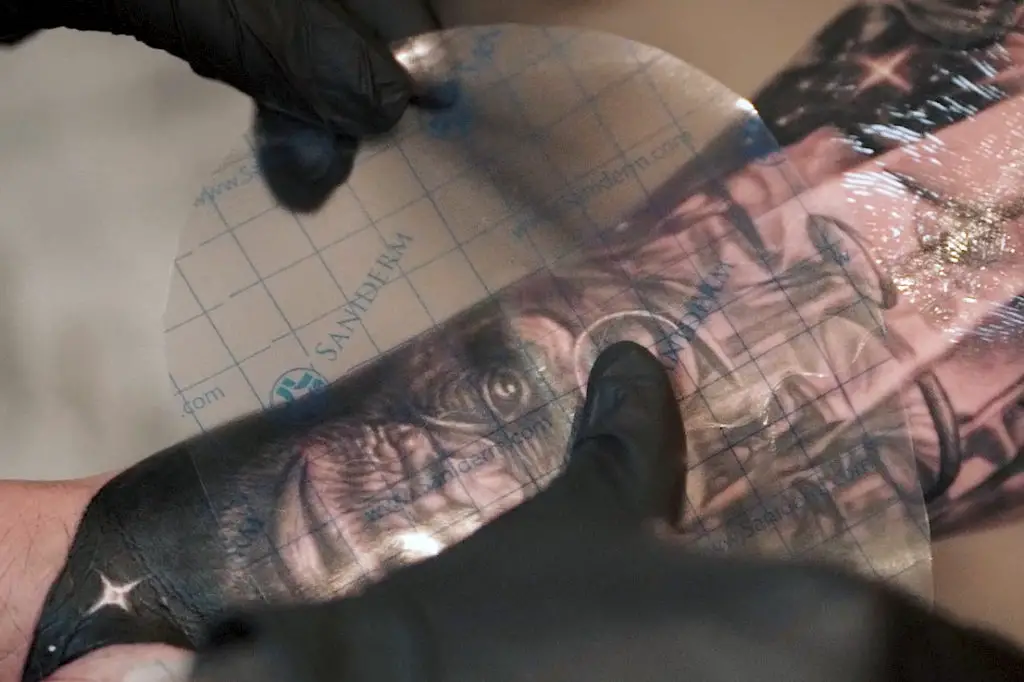What do you think of when you hear the term mylar blankets? If you aren’t sure, that’s okay; maybe you are more familiar with the terms survival blanket, space blanket, or foil blanket. Regardless of what you call them, mylar blankets can be a critical tool for survival, emergencies, and first aid scenarios. By the time you are finished reading this, you’ll see why carrying a mylar blanket with you on your next adventure is a great idea.
What are mylar blankets, and what are they made of?
Do space blankets come from space? Not exactly. Although the materials that mylar blankets are made of were designed by NASA in the mid-1960s, the material didn’t prove its usefulness until the 1970s.
In the 1970s, a NASA space station was overheating due to the constant exposure to the sun’s infrared rays. NASA’s scientists and engineers worked to find a solution to protect their equipment from overheating. What was their answer? A thin sheet of plastic mixed with vaporized aluminum. This material was successful in deflecting the heat away, preventing damage from outside. To read about the whole story of mylar blankets, click here.
The thin plastic film and vaporized aluminum are the primary materials that create mylar. Today, you can find this material in various forms, including disposable blankets, reusable blankets/shelters, and even sleeping bags.
How do mylar blankets work?
We lose heat in three ways, conduction, convection, and radiation.
- We lose heat from conduction by touching something colder than our body temperature.
- We lose heat from convection when we stand outside on a windy day.
- Our body naturally gives off heat without having to touch anything through radiation.
As you saw from NASA’s original use of the mylar material, space blankets reflect heat. This is very helpful to the user because a majority of heat loss comes from radiation. Many manufacturers of space blankets say that their product reflects up to 90% of heat back to the user. Survival blankets are also windproof, which helps prevent heat loss through convection. Since the material is thin, it does not provide much insulation, so you could still lose heat through conduction.
Disposable vs. reusable emergency blankets
There are many varieties of foil blankets, but there are two main categories: disposable and reusable.
Disposable space blankets can be used more than once if you’re careful; however, they aren’t necessarily designed to be used more than a couple of times. The reflective material can rub off or tear easily, which will reduce the blanket’s ability to effectively direct heat back to the user. They are also extremely thin and can tear easily. But they are inexpensive and lightweight, so you can carry more than one in your survival or first aid kit without it being cumbersome.
Reusable survival blankets can be used more than a couple of times. They are designed with mylar and in combination with a more robust material that makes them resistant to tearing. They are a little more expensive and heavier than the disposable variety; however, they do offer much more versatility when it comes to applications, which I will talk about later.
How/when to use a Mylar blanket for first aid
Hypothermia
Foil blankets are helpful in situations where you are treating hypothermia or rapid heat loss. Hypothermia can be caused by many things, such as prolonged exposure to cold weather or falling in cold water. Before you can use your space blanket to treat someone with hypothermia, you need to recognize the signs and symptoms of hypothermia.
Types of Hypothermia
- Our normal body temperature is 98.6 degrees Fahrenheit.
- Mild hypothermia starts at 95 degrees Fahrenheit.
- Moderate hypothermia begins at 89.6 degrees Fahrenheit.
- Severe hypothermia begins at less than 82.4 degrees Fahrenheit.
Signs and symptoms of mild hypothermia
- Shivering and chattering teeth.
- Rapid heart rate (over 100 beats per minute)
- Rapid breathing (over 20 breaths per minute)
- Decreased coordination/Clumsiness
Signs and symptoms of moderate hypothermia
- A decline in mental function/altered mental status
- Slurred speech
- Muscle stiffness
- Loss of shivering
Signs and symptoms of severe hypothermia
- Absence of reflexes
- Loss of consciousness
- Coma
- Death
Treatment
Mild hypothermia is easily treatable at home, while moderate and severe hypothermia needs to be treated at the closest appropriate medical facility. There are a few essential things you can help with providing first aid to someone with hypothermia regardless of the severity though.
- Remove the person from the cold environment.
- Remove any wet clothing (wet clothes cause us to lose heat 5-times faster).
- Start working on slowly warming the person up.
If you use your space blanket to treat someone with hypothermia, remember the space blanket does not provide insulation. You will need to provide an insulating layer with dry clothes or a blanket prior to placing the foil blanket on top of the person. If you cannot provide an insulating layer, your space blanket will still be better than nothing; it just may not work as well. When you use your emergency blanket, make sure the shiny side is down since that is the side designed to reflect the heat back.
Mylar blankets for trauma and shock victims
You can also use your space blanket to provide first aid to victims of trauma or shock. If there is a significant disruption in oxygen reaching the cells in our bodies, we will go into shock.
There are about five different types of shock, but I will focus on hypovolemic (low blood volume) shock because it is most commonly associated with traumatic events.
3 phases of shock
Imagine you are with someone who cut their leg, and there has been a lot of blood loss. That person will go through three phases of shock: compensated, decompensated, and irreversible. How quickly that person progresses through the three phases depends on how much blood they lose.
Normal adults carry about 5-liters worth of blood at any given time. We can lose up to 14% of our blood volume without any symptoms of shock. Once we lose 15-30% of our blood volume, we may become tired, our extremities may become pale and cold to the touch, and our heart and respiratory rates will increase. After we lose 40% of our blood volume, our body begins to shut down, and we will likely lose consciousness.
Treatment of hypovolemic shock
Suppose someone has lost a lot of blood or suffered significant trauma. In that case, they need to be rapidly taken to the closest appropriate medical facility because we won’t be able to treat shock without special training and tools.
If you cannot get help right away, there are some things you can do to help improve the person’s outcome.
- If the bleeding is external, stop it by applying direct pressure or a tourniquet.
- Call 9-1-1 or get help as quickly as possible.
- Treat for hypothermia and monitor their mental status (ability to answer questions or follow directions – see AVPU). A significant decrease in mental status can mean the person is progressing from compensated to decompensated shock or decompensated to irreversible shock.
As you just saw, your space blanket is a valuable tool in treating someone for hypothermia. When you use your space blanket for treating a trauma victim, the same rules apply when treating someone for cold exposure.
How to use an emergency blanket for survival
Emergency blankets are versatile tools to carry in your survival kits. They are lightweight, compact, and have many practical uses, making them ideal for bringing on your next outdoor adventure.
Emergency shelter
Space blankets make building an emergency shelter easy. The simplest shelters to build with your blanket are the lean-to or a-frame. Although a tarp is better for this purpose, tarps are not as compact and do not have the same heat-reflecting material to keep you warm/cool.
If you are in a cold environment, you can position the reflective material inwards to retain heat. If you are in a hot environment, you can place the reflective material outwards to deflect heat and provide shade. Since the space blanket’s material is windproof and waterproof, you will also have protection from the elements.
It doesn’t matter if you pack a disposable or reusable blanket because either one can be used to build a shelter; however, I recommend using a reusable blanket. Reusable blankets, like the All Season Blanket from SOL, have metal grommets to feed ropes through, making them easier to hang. You can still hang the disposable type, but you would have to cut your own holes.

Carry-all
Survival blankets can all be great as a carry-all. This would allow you to efficiently carry more materials, such as firewood, back to your shelter than just using your hands. Once again, I would recommend using the reusable type because the more durable construction will resist rips and tears.
Fire reflector
You can use your mylar blanket to reflect the heat from a fire back onto you in your shelter. Simply hang the shiny side facing you and your fire to increase the warmth. When using this technique, it is vital that you do not hang your blanket too close to the flames. While space blankets aren’t flammable, they will burn if exposed to direct flames, and they will give off toxic fumes as a result.
Shelter liner / Ground Cloth
Mylar blankets are also useful shelter liners. Remember, they do not provide insulation; however, you can lay down a layer of pine needles before placing the blanket on top.
I was on a search and rescue team for 4-years. I participated in many survival-type pieces of training, including a winter survival course. We hiked into the snowy mountains and built snow caves to sleep in. I used a survival blanket to line the inside of my snow cave, and while it was not as warm as sleeping inside of a well-heated house, I was comfortable enough not to wake up freezing cold in the morning.
Signaling
The shiny side of your survival blanket can be more helpful than just reflecting heat. You can use the shiny side as a giant signaling mirror for aircraft, making it easier to find your location.
Things to keep in mind with space blankets
- Your foil blanket will not be as warm as your favorite fleece blanket at home. Just because you are using one does not mean you will be instantly warm or that you will not get cold; however, you will be warmer with a survival blanket than without one.
- In my experience, they also do an excellent job of protecting you from light winds, but not more than 20mph or so. The poncho version of a space blanket is better for these conditions.
- Foil blankets are waterproof, so they do retain moisture on the inside. When you use one for an extended period of time (like sleeping wrapped in one overnight) it will retain your body moisture and cause you to get wet. This can make your situation worse, especially if you’re using one inside of a down sleeping bag. Keep a layer or two between your skin and the foil blanket to allow for some air movement and keep outside of a down sleeping bag.
- If your survival blanket gets a tear, you will need to repair it right away. A small tear will quickly progress into a large one if it isn’t addressed. Duct tape seems to be a quick and easy way to repair your blanket as an emergency fix, but I would replace your blanket when you have a chance.
Final thoughts
Mylar blankets are a versatile tool to carry in your first aid, emergency, or survival kit. They are so lightweight and compact that you will not be able to even tell it is there, but you will be thankful that you have one when the situation arises.






